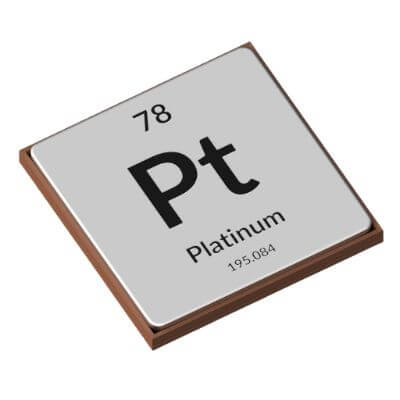
- Name: Platinum
- Symbol: Pt
- Atomic Number: 78
- Atomic Weight: 195.084
- Period: 6
- Group: 10 (nickel group)
33 Platinum Facts for Kids
- Platinum is a chemical element on the periodic table.
- Platinum is named after the Spanish phrase “platino” which translates to “little silver”.
- Platinum is a dense precious metal with a silvery white color that is both ductile and malleable.
- Platinum was discovered in trace amounts of gold by archeologists in ancient Egyptian burials dating as far back as 1200 BC. However, French scientist and explorer Antonio de Ulloa is credited with the discovery of platinum in 1735. Ulloa took samples from Colombia and Peru and established a mineralogy lab in 1748 to study platinum.
- The symbol for platinum is Pt.
- The atomic number for platinum is 78.
- The standard atomic weight for platinum is 195.084 u.
- Platinum is a solid at room temperature.
- Platinum is in the transition metal element category on the periodic table.
- Platinum is a period 6 chemical element, which is the sixth row on the periodic table.
- Platinum is a group 10 chemical element, which is the nickel group.
- Platinum is in the d-block on the periodic table.
- The electron configuration for platinum is [Xe] 4f14 5d9 6s1.
- The electrons per shell for platinum are 2, 8, 18, 32, 17, 1.
- Platinum has four stable isotopes.
- The four stable isotopes for platinum are 194Pt, 195Pt, 196Pt and 198Pt.
- The melting point for platinum is 3214.9 °F (1768.3 °C).
- The boiling point for platinum is 6917 °F (3825 °C).
- Platinum is the 8th rarest chemical element in the Earth’s crust.
- According to the USGA, the world produced 209 tons of platinum in 2018.
- According to the USGA, the largest producer of platinum in 2018 was South Africa with 151 tons.
- According to the USGA, South Africa produced over 72% of the world’s supply of platinum in 2018.
- Based on data from the USGA, the world’s proven reserves of platinum and palladium is over 76,000 tons.
- Based on data from the USGA, South Africa holds over 90% of the world’s proven reserves of platinum and palladium.
- In 2019, the average price for an ounce of platinum was $812.20.
- Since platinum is a precious metal it’s used as a currency and is bought, held and sold as an investment. Platinum can be bought as an investment via the stock market, bars, coins or ingots.
- Platinum is used in jewelry because of its resistance to corrosion and that it doesn’t oxidize at any temperature.
- In 2014, it’s estimated that 45% of all platinum production was used in vehicle emissions control devices.
- In 2014, it’s estimated that 34% of all platinum production was used in jewelry.
- In 2014, it’s estimated that 9.2% of all platinum produced was used in petroleum refining and chemical production.
- In 2014, it’s estimated that 2.7% of all platinum produced was used in electronic devices, like PC hard drives.
- Between 1889 and 1960, the length of a meter was defined by the length of a platinum-iridium (90:10) alloy bar.
- Moon rocks and meteorites discovered on Earth contain more platinum than on Earth.
Additional Resources on Platinum
- Platinum (Pt) – Discover more about the chemical element platinum on the Los Alamos National Laboratory website.
- Platinum for Kids – Find more information about the chemical element platinum for kids on the Britannica Kids website.
- Platinum and Your Health – Learn about the benefits and/or risks of platinum to your health on the CDC website.
- Platinum – PubChem – Read more about platinum and the data behind it on the NIH PubChem website.
